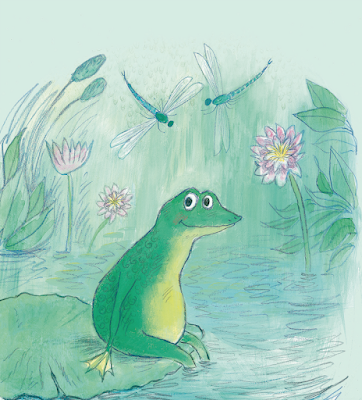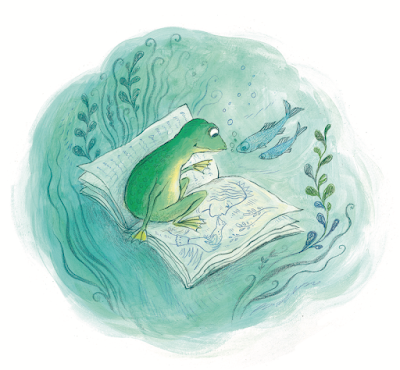ON FAIRYTALES James Mayhew and Toto Martinez
Be they echoes of tales from long ago, retellings, or twisted and fractured mash-ups – fairytales never lose their appeal. This issue, deputy editor Françoise Price talks to husband and husband team James Mayhew and Toto Martinez about their new picture book, The Frog's Kiss.
Hi James and Toto and welcome to Words & Pictures. What made you decide to make a book together and how did you choose this particular story?
James:
Obviously I’ve been working on books for many years, and Toto has seen the process, and also been on a couple of courses, including a Summer School at Cambridge School of Art, as well as accompanying me on courses I’ve tutored. So he’s learned a great deal about the industry, and it seemed an obvious thing to try, especially as he is brimming with great ideas!
Toto:
It came naturally, it wasn’t a sudden idea. I had the idea for the story first. I chose it because we have a pond in the garden and I love seeing the frogs…
Preliminary studies for The Frog's Kiss, by James Mayhew and Toto Martinez
The book is a reimagining of the classic tale, The Frog Prince, a German story from Grimm’s Fairytales. How does yours differ from the original?
James:
The kiss with the frog isn’t in the original — the princess throws the frog against a wall! In other more modern tellings, the transformation is with the famous kiss — perhaps inspired by Sleeping Beauty or similar fairytale tropes. So we took the idea of the kiss, and made the story about the frog. In our tale, there are three princesses, none of them very forthcoming. But kindness wins the day in the guise of a handsome prince — who offers the famous (consensual) kiss.
There is also the underlying theme of representation in books (or the lack of it). We see the prince discarding a book at the start of the story. The frog then sees this book, with an illustration of a frog kissing a princess. Because the book tells him so, he believes he must likewise kiss a princess. So the book within the book represents the fairytales that I grew up with — which taught me that boys (and princely frogs) only kissed princesses (girls).
You co-wrote and co-illustrated The Frog's Kiss (published 11th May 2023, Scholastic UK). What were the challenges? Did you have any disagreements about aspects such as style of illustrations and use of language?
James:The initial idea was Toto’s, and the writing was relatively straightforward. He narrated to me, I wrote it down, he edited it, and we ping-ponged the story back and forth like that. With the illustrations it was more complex as obviously I’m more experienced (and set in my ways!). Toto’s art background is in theatre and costume design, so he designed all the fabulous costumes, and added decorative details throughout, like waterlilies and garlands of pondweed. The frog character we created together, just by drawing and redrawing hundreds of frogs! All the art was created with real paints and tools — we don’t work digitally. This, I think, allowed a closer collaboration. In a way, it was quite romantic.
'Toto designed all the fabulous costumes, and added decorative details
like waterlilies and garlands of pondweed'
What were your favourite fairytales growing up?
James:
I loved rather melancholy tales like The Snow Queen and The Little Mermaid (Andersen), and I was also fascinated by the Thousand and One Nights. But I also really loved Beauty & the Beast — which has many parallels with The Frog Prince story. I was always drawn to stories with an “underdog” (or “underfrog”!), and I was always on their side.
Cinderella! I loved stories with magic transformations — and the costumes of course! Where I grew up, in Catalunya, we have many festivals, often with legends around them. The most famous is Sant Jordi (St. George). According to the legend, the dragon’s blood became red roses and, on this festival day, we give our lovers books and roses.
Toto:
Cinderella! I loved stories with magic transformations — and the costumes of course! Where I grew up, in Catalunya, we have many festivals, often with legends around them. The most famous is Sant Jordi (St. George). According to the legend, the dragon’s blood became red roses and, on this festival day, we give our lovers books and roses.
Your book is published in time for Pride month in June. Would you like to see more inclusivity in the fairytale canon?
James:
Yes, I think it’s absolutely necessary! Within history, there are in fact several tales that might be considered LGBTQ or “Queer” today, especially Greek myths. They fell by the wayside because of homosexuality laws. So the canon of folktales or fairytales that survived is quite narrow. It would be interesting to revive hidden or lost tales, but also, as with The Frog’s Kiss, add to the genre. For us, it was really important to not simply create an “issues” book or one that would sit on an LGBTQ shelf. We wanted a really beautifully illustrated classic fairytale feel in our book, and we worked really hard to achieve that. We are very proud of the result. We think it’s a book that can simply be in any fairytale library to be enjoyed by all children.
I love folklore, myths, legends and fairy tales, and several of my other books touch on the genre. Koshka’s Tales of course, a collection of Russian fairy tales (Graffeg), Ella Bella Ballerina explores fairytales, as featured in famous ballets, like Sleeping Beauty, Nutcracker, Cinderella (Hachette). Then there’s Once Upon A Tune, a collection of fairytales and legends immortalised in classical music (Otter-Barry).
For many years I designed sets and costumes and props for a pantomime company. These were all based on classic fairy tales like Aladdin, Cinderella, Jack and the Beanstalk, Puss in Boots, Babes in the Wood. I got to know these stories really well by working on these shows.
(Top and above) Finished artwork for The Frog's Kiss
Tell us about other works that either (or both) of you have been involved with that enter the realm of fairytale.
James:
I love folklore, myths, legends and fairy tales, and several of my other books touch on the genre. Koshka’s Tales of course, a collection of Russian fairy tales (Graffeg), Ella Bella Ballerina explores fairytales, as featured in famous ballets, like Sleeping Beauty, Nutcracker, Cinderella (Hachette). Then there’s Once Upon A Tune, a collection of fairytales and legends immortalised in classical music (Otter-Barry).
Toto:
For many years I designed sets and costumes and props for a pantomime company. These were all based on classic fairy tales like Aladdin, Cinderella, Jack and the Beanstalk, Puss in Boots, Babes in the Wood. I got to know these stories really well by working on these shows.
This is your first book together — are there others planned?
Toto:
Yes it is! And we really hope so… we have many ideas and are discussing them with publishers.
Fairytales often touch on the concept of ‘happily ever after’ and traditionally this has been in the context of a straight, white marriage. How does subverting the traditional fairytale help to redefine these myths?
James:
It’s easy to take those endings for granted — and it becomes not just an ending, but an expectation. That’s what we are trying to change — the psychology where that is the hoped for outcome. We know why stories have ended up this way: the Victorian era, the laws in Western countries, the racism and homophobia that infiltrated both word and image. But we also know that these tales, still existing in dated versions, can be damaging. Children of colour should be able to hope for happiness, and so should those who feel they are different in other ways. They may not yet know anything about their orientation, but stories like this are about paving the way for everyone to be accepting and to have empathy with people who may be different to themselves. I think new tales like these also encourage a healthy critical view of older tales, and certain retellings. Certainly things like non-consensual kisses are no longer just acceptable!
Cover of The Frog's Kiss, by James Mayhew and Toto, published by Scholastic UK
Can you recommend other examples of fairytales and retellings that encourage the reader to look at the world in fresh ways and subvert the stereotypes?
Toto:
Nen and the Lonely Fisherman by Ian Eagleton (published by Owlet Press and illustrated by James) is a really great example. I was so proud of my husband when that book won the inaugural Polari Prize for a children’s book!
James:
As I mentioned earlier, there are some really interesting Greek myths — like Apollo and Hyacinth. There is also some exploration of gender stereotypes in ancient Asian stories, like the Chinese tale of The Butterfly Lovers, and in the story of Prince Camaralzemen and Princess Badoura in the Thousand and One Nights. In both tales the women dress as boys, and cause some interesting relationships to develop!
Do you think it’s important to keep the fairytale genre alive and will it ever be a thing of the past?
James:
It is already “of the past”, but that is something to celebrate. These stories, in their many versions, are hugely significant as examples of different cultures and social change. We should never throw all that away. BUT we must always remember that, with the exception of literary fairytales, these stories were told — passed down to each generation by word of mouth, ever changing, ever transforming, like our magic frog, into something g new and different. These are tales full of magic and yearning and power and imagination. They take us all around the world, and we learn so much about history and place from them. However, they need to be kept fresh, they need to be challenged and retold, they need to live and breathe for today’s society too. We both really hope The Frog’s Kiss can be part of that new tradition. New tales for old, to quote from Aladdin!
*Header image: Tita Berredo
*
James Mayhew (pictured above, left) has been creating books for children for over 30 years. Alongside his work in publishing, James also works with orchestras and musicians, presenting concerts that combine music and art, created live on stage. He lives in Suffolk with his husband Toto, and Diva the dog.
Spanish-born artist “Toto” (Antonio Reche Martinez) was born at the foot of Montserrat mountain, near Barcelona. He has designed everything from operas (Verdi’s “Aida”, Olesa de Montserrat) to pantomimes and puppet shows. He came the the UK to study at the London School of Fashion. He has also worked as a tapas chef, a make up artist, and a Spanish language teacher. The Frog’s Kiss is Toto’s first book.
*









%20respira%20fotografia.jpg)








What a great collaboration, congrats James and Tota, and of course I always welcome more books about frogs! : )
ReplyDelete